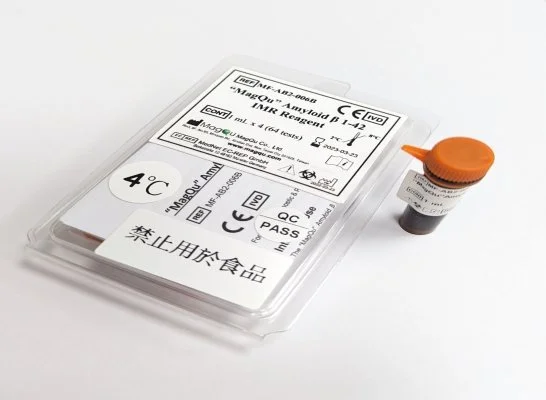Amyloid β 1-42 IMR Reagent
“MagQu” Amyloid β 1-42 IMR Reagent is designed for quantitative measurement of Tau protein concentration in human plasma by immunomagnetic reduction (IMR) assay. The reagent can be used with MagQu’s Magnetic Immunoassay Analyzer XacPro-S system.
This assay enables early-stage neurological disease research with ultra-high sensitivity and low interference.
Features
Ultra sensitivity
Low interference
Easy operation
Diagnosis of
- Alzheimer’s Disease (AD)
- Mild cognitive impairment (MCI)
- Down’s syndrome
Specifications
Sample type: Human Plasma
Sample volume: 60 μl
Assay time: 5 hours (36 channels in XacPro-S)
Use application: In vitro diagnostic
Detection methods: ImmunoMagnetic Reduction (by analyzer XacPro-S with magnetic reagents)
Sensitivity
Detection Range: 1 - 100 pg/ml
Low detection limit: 80 fg/ml
IMR standard curve of Aβ1-42
Description
Intended Use
“MagQu” Amyloid β 1-42 IMR Reagent is used to quantitatively measure Aβ1-42 protein in human fluid specimen, such as plasma.
Use “MagQu” Amyloid β 1-42 IMR Reagent only with the XacPro-S System (MagQu Co., Ltd.).
Introduction
Amyloid β (Aβ or Abeta) denotes peptides of 36–43 amino acids that are crucially involved in Alzheimer's disease as the main component of the amyloid plaques found in the brains of Alzheimer patients. The peptides result from the amyloid precursor protein (APP), which is being cut by certain enzymes to yield Aβ. One of the most common isoforms is Aβ1-42.1,2
Principles of Test
“MagQu” Amyloid β 1-42 IMR Reagent is designed for rapid quantifying Aβ1-42 protein by Immuno Magnetic Reduction (IMR). We conjugated the antibody on the surface of around 50 nm-in-diameter Fe3O4 magnetic particles. When the antibodies on the surface bind with Aβ1-42 protein, the magnetic particles form clusters. Therefore, the ac susceptibility (Xac) of magnetic particles would be reduced in the adding ac magnetic field. By measuring the reduction of Xac, we can quantify Tau protein in the sample easily, rapidly, and accurately.3
Reagent Properties
Precision
The Aβ1-42 samples were measured in duplicate,
twice per day over 20 days. Two different Aβ1-42
concentrations were used for the tests.
The standard deviations of repeatability and with-
in-lab for various Aβ1-42 concentrations ware
obtained.
Interference (Specificity)
Plasma can contain interfering substances such as hemo-
globin, bilirubin, or intra lipid because of common
diseases, such as hemolysis, jaundice or hypertriglyceri-
demia. Other bio-substances that exist naturally in plasma,
such as uric acid, rheumatoid factor, or albumin, are also
interfering substances.
Other interfering substances include drugs or chemicals in
medicine that is used to treat inflammatory diseases, viral
and bacterial infections, cancers and cardiovascular
disease. The level of Aβ1-42 in each of these pools was
then determined and normalized to the level without the
respective substances.
Expected Value
Fig 1:IMR and ELISA were applied to assay Aβ42 in plasma and CSF, respectively. A moderately negative correlation between plasma and CSF Aβ42 levels in AD patients (r = –0.352), and a weakly positive correlation in controls (r = 0.186). (refer to reference 1)
Fig 2: Fig.2 (a) Concentration products of Aβ-42 and tau protein in plasma from different clinical groups, detected using immunomagnetic reduction, and the ROC curves to distinguish (b) the healthy control group from t he patient group (combining MCI due to AD, very mild AD, and mild-to-severe AD dementia) and to distinguish (c) the MCI due to AD and the AD dementia groups. (refer to reference 2).
Application References:
1. Fan Ling-Yun et al., “The Relation Between Brain Amyloid Deposition, Cortical Atrophy, and Plasma Biomarkers in Amnesic Mild Cognitive Impairment and Alzheimer’s Disease” Front. Aging Neurosci. 2018; 10:175.
2. Chiu Ming-Jang et al. “Combined plasma biomarkers for diagnosing mild cognition impairment and Alzheimer's disease” ACS chemical neuroscience. 2013; 4:1530.





